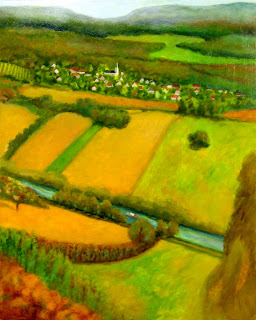
As we headed south toward Saigon along Route 1, "Route of the Mandarins," we got our first glimpse of the Vietnamese countryside. Extensively cultivated, the land was dotted with small villages that passed by in a heartbeat. The lush, green fields were covered with small, family-owned plots planted next to their neighbors in a seemingly haphazard fashion. Their tidy rows, seldom aligned with those adjacent to them, created a veritable quilt of textures and colors. Often on these green quilts of land we saw solitary figures kneeling or bending in arduous postures as they toiled. In one rice field there was a man irrigating his land with two huge watering cans held on a bamboo "don gaha." I promised never to complain about gardening again.

Vietnamese Countryside, Oil Painting
On our first day in Vietnam we drove into Hanoi. I was so overwhelmed by the strangeness of the place that I put away all my preconceived notions of what the country would be like. It was impossible to reconcile the image of the languid French Indochine I had seen in the movies with the chaotic activity and energy I was now confronted with. It was like no other city I had ever visited.
Waves of small motorcycles, mopeds and bicycles surged around our bus and I spotted one cycle carrying a bamboo cage filled with live dogs. Were they soon to be someone’s dinner? Block after block of strange narrow, patched-together buildings huddled over their ground floor commercial enterprises. Cheap, colorful merchandise spilled out onto the sidewalk where people were cooking over open braziers, squatting down for a chat, or even having a manicure. Everywhere life was overflowing. Whole families on a single motorcycle (mothers often carrying children in their arms sitting behind their husbands). Young women, exquisitely dressed in the sexy, clinging bao dai wearing the odd accessories of the commuter (face mask, opera length gloves, head scarves) to protect against the pollution. Each driver, without exception, wore a helmut because It is the Law! and this is not a democracy.

Cafe Quynh on Bat Street, Oil Painting
On a walk through Hanoi’s old quarter, which dates back to the 11th century, we glimpsed the Cafe Quynh on Bat Dan Street with the ubiquitous cycles parked in front. Inside patrons were enjoying the respite of a coffee break because, unlike the rest of tea-drinking Asia, coffee is taken seriously in Vietnam. Could a Starbuck’s be in their future?

Cao Dai Medallion, Fusion Glass
The first hint of more felicitous surprises to come was our sojourn north where we visited the spectacular, James Bond Location-Shoot Extraordinaire -- Halong Bay in the South China Sea. On an overcast day, we motored aboard a Chinese junk between hundreds of small, uninhabited rock and tree covered islands. That night on the ship we dreamt of pirates, magical caves filled with stalagmites and trees alive with fugitive monkeys.
As we turned south heading back to Hanoi, we stopped at a Cao Dai Temple and our eyes experienced a huge transfusion of riotous color after days of muted, dust-covered surroundings. The exuberant tenants of this religion extol the diversity and joy of life, basically including all who wish to follow.

Vietnamese Angel, Tho Ha Village
One of my favorite experiences along the way was our visit to the Tho Ha Village on a river peninsula. All the inhabitants were involved in one enterprise...making rice paper for noodles and spring rolls. Large bamboo paniers covered the rooftops, leaned against walls and canopied overhead bridging the walkways. Children skittered around, laughing and shouting xin chao (hello in Vietnamese). Fortunately, I was able to capture the image of a lovely but shy Vietnamese princess sitting in front of a sheet of rice paper. She was an angel in pink barrettes.

Mekong Delta, Oil Painting
Other stops on our trip, so numerous I cannot mention them all in detail, were: Hue, with its Forbidden City where the king lived at one time; Hoi An, a popular destination with young travelers who gather in the cafes and shop in the vibrant market; Nah Trang, known as the Vietnamese Riviera with a spectacular view of the South China Sea and, just before Saigon, Da Lat, once the summer retreat of the French colonials with scenery straight out of Switzerland.
Flying into Saigon after being in the countryside for almost two weeks was like approaching a vast mystical metropolis. Here the weather was considerably warmer, the city was larger and more varied, but one thing was the same--the unrelenting onslaught of motorcycles. Everyone was outside even in the evenings, escaping their apartments and searching for cooler air. It was just like New York City in August, but it was winter in Saigon!
One day we drove outside the city to visit the Chu Chi Tunnels, a network of underground passages that still surround Saigon. Built during the American War , it allowed the Viet Cong to “pop-up” seemingly out of thin air and terrify the Americans and their allies. We watched a propaganda tape from the war years and, crawling through the passageways, we learned the secrets of the tunnels.
We spent a day on the Mekong Delta with its floating markets and wafer-thin buildings all done in a collection of bizarre architectural styles. Here we touched a honeycomb covered with bees without getting stung, wrapped a cobra around our shoulders and wore it like a shawl, ate an elephant ear fish for lunch (a crispy and delicious sculpture on a stick) and felt again the amazing hospitality of the Vietnamese people.
Our farewell dinner in Saigon began with a lotus flower, its petals folded back, placed at every seat. It was a fitting symbol of the beauty and delicacy we had found in Vietnam. There were tears in our eyes as we said goodbye to our guide Tea who we all adored and who had taught us so much about the country and the people he loves.
























